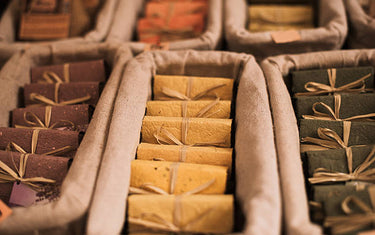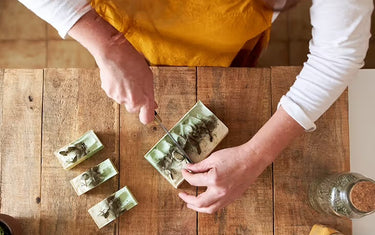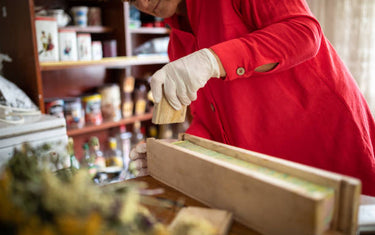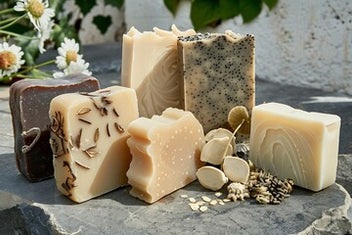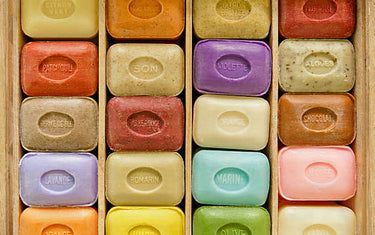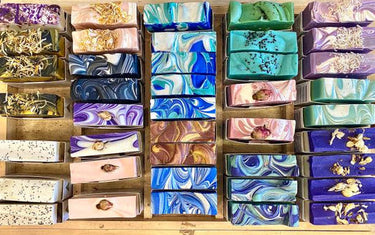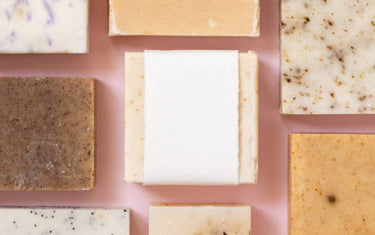9 min read / 1 October 2024 / yasmin sharp
5. Selling Handmade Soap Regulations: UK Guide
Learn essential soap-making safety tips, proper lye handling, ventilation, labelling, and legal requirements to ensure compliance and safe practices.
Share this post
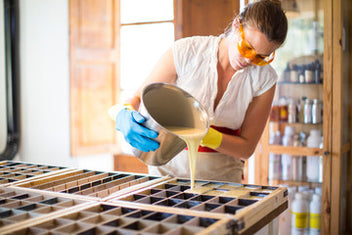
A comprehensive guide to handling lye, ensuring proper ventilation, and understanding legal requirements and regulations.
Whether you’re a hobbyist or a business owner, soap making safety is paramount in the production process.
While it can be easy to get caught up in the fun of soap making, putting yourself and your customers first is essential for success.
Below, we’ll guide you through the essential areas of homemade soap making safety, cosmetic product regulations, and how to handle lye.
You’ll also gain an in-depth understanding of the legal requirements for labelling and selling handmade soap, as well as cosmetic product regulations.
By following these guidelines, you'll be able to craft high-quality, safe, and legally compliant products. You can also find out basics of how to make soap if you’re a beginner.

Selling handmade soap in the UK involves understanding and complying with specific legal requirements. Below, we'll break down all there is to know.
Regulatory Requirements
When selling handmade soaps, you must comply with UK regulations, including Good Manufacturing Practices (GMP) and safety assessments. Below are the key areas to address:
Product Information File (PIF)
The PIF is a crucial document required for selling cosmetic products like handmade soaps. It includes all the details necessary to prove your product's safety and compliance. Here's what's included:
- Product composition, quality and specifications
- Manufacturing method and GMP compliance
- Safety assessment report (CPSR)
- Data on animal testing (if applicable, though testing cosmetics on animals is banned in the UK)
- Proof of compliance with notification requirements
- Manufacturing methods and records
- Stability and shelf-life data
- Detailed labelling and packaging information
- Evidence of notification through the CPNP
- Undesirable effects
- Name and place of manufacture
- Detailed description of your handmade soap
Good Manufacturing Practices (GMP)
GMP ensures that your soap-making process is consistent and safe. Adopting these practices involves:
- Maintaining a clean and organised workspace
- Documenting manufacturing processes
- Keeping records of raw material purchases and usage
Safety Assessment (CPSR)
You’ll need to understand what is an CPSR and how to obtain one, as without this you cannot legally sell your soap.
Before selling your soap, it must undergo a safety assessment by a qualified professional. The Cosmetic Product Safety Report (CPSR) is a legal requirement under UK regulations.
Information needed for a safety assessment:
- Full list of ingredients with INCI names (International Nomenclature of Cosmetic Ingredients)
- Usage levels and concentrations of each ingredient
- Manufacturing methods
- Proof of GMP compliance
- Product specifications (e.g., pH levels, stability testing results)
Allergen Declaration
Label your soap with clear allergen information. If your soap contains any of the 26 recognised allergens, they must be listed on the label, especially if they exceed specific thresholds.
The 26 recognised allergens that must be declared on cosmetic product labels in the UK and EU (including handmade soap) if present above specified thresholds are:
- Amyl cinnamal
- Benzyl alcohol
- Cinnamyl alcohol
- Citral
- Eugenol
- Hydroxycitronellal
- Isoeugenol
- Amylcinnamyl alcohol
- Benzyl salicylate
- Cinnamal
- Coumarin
- Geraniol
- Hydroxyisohexyl 3-cyclohexene carboxaldehyde (Lyral)
- Anise alcohol
- Benzyl cinnamate
- Farnesol
- Butylphenyl methylpropional (Lilial)
- Linalool
- Benzyl benzoate
- Citronellol
- Hexyl cinnamal
- Limonene
- Methyl 2-octynoate
- Alpha-isomethyl ionone
- Evernia prunastri extract (oakmoss)
- Evernia furfuracea extract (treemoss)
Thresholds for Declaration
- Rinse-off products (e.g., soap): 0.01% or more.
- Leave-on products (e.g., lotions): 0.001% or more.
These allergens must be listed in the ingredients under their INCI names, regardless of whether they are naturally occurring in essential oils or added separately.
OPSS and Notifications
The Office for Product Safety and Standards (otherwise known as the OPSS) oversees cosmetic product safety in the UK. As part of your compliance, you must notify the Cosmetic Product Notification Portal (CPNP) about your products before selling them.
Every time you make a new version of one of your products, you will have to submit a new notification. This can be done using the portal on the UK government website.
Ban on Animal Testing
Animal testing for cosmetic products is banned in the UK. Ensure that your ingredients and final products adhere to this regulation and have not been tested on animals at any stage.

Soap Labelling Requirements
Creating Compliant and Informative Labels for Your Soap
Why Labelling is Important
Labelling is a legal requirement that ensures consumer safety and helps provide important information about the product. This can help your customers to make informed decisions about the products they’re buying.
Additionally, proper soap labelling can reduce the risk of allergic reactions by clearly listing all ingredients. Complying with labelling regulations is important if you want to run a legitimate soap business.
Essential Soap Labelling Components
When it comes to labelling handmade soap, there are a handful of essential product label requirements that you need to include. Here’s what to note on your soap labelling:
- Ingredients: List all your soap ingredients in descending order of predominance. This transparency is important for consumers (especially those with allergies or sensitive skin) so they know what they are purchasing.
- Weight: Clearly state the net weight of the soap. This should be measured in grams or ounces.
- Manufacturer Details: Include the name and address of the manufacturer or distributor. This information is essential for traceability and customer service.
- Warnings: If your soap contains any ingredients that could cause irritation or are not suitable for certain skin types, these warnings must be clearly stated on the label. This will help reduce the risk of any potential adverse reactions.
Design Tips
An effective label is both informative and visually appealing. Use legible fonts and high-contrast colours to ensure the information is easy to read.
You may also want to consider using waterproof labels to prevent smudging, which can occur when the soap comes into contact with water. Well-designed labels not only meet regulatory requirements, but can also help make a product more visually appealing.
Legal Considerations for Selling Soap
Navigating the Legal Landscape of Soap Selling
Understanding Your Obligations
If you’re planning to sell your handmade soap, you must have a strong understanding of the legal framework that governs cosmetic products.
In the UK, soap is often regulated as a cosmetic product. This means it must comply with specific cosmetic product regulations.
These regulations ensure that your soap is safe for use, properly labelled, and manufactured according to Good Manufacturing Practices (GMP).
Understanding these obligations is essential if you want to avoid legal issues. For example, you’ll need to understand what is an CPSR and how to obtain one, as without this you cannot legally sell your soap.
Registering Your Business
One of the first legal considerations for selling soap is legally establishing your business, which involves several key steps.
First, you need to register your business name and obtain any necessary permits. You may also need to register with the appropriate cosmetic regulatory bodies.
In the UK, you would typically need to notify the Cosmetic Product Notification Portal (CPNP) before your products can be sold. This registration ensures your business complies with all relevant laws and regulations.
Insurance and Liability
Product liability insurance for soap making businesses is a necessity and will help protect you if a customer has an adverse reaction.
It’s advisable to consult with an insurance provider to understand the coverage options available. This will help give you peace of mind and will also protect your business from potential legal claims.
Staying Updated
The regulations surrounding cosmetic products can change over time, so you must keep yourself up to date.
For example, check updates from regulatory bodies such as the Medicines and Healthcare products Regulatory Agency on a regular basis.
Understanding and adapting to these regulatory changes will help you maintain compliance and protect your soap business. It also means you can implement best practices in your soap making process.

Handling Lye Safely
The Importance of Lye Safety in Soap Making
What is Lye?
Lye, also known as sodium hydroxide, is a key ingredient in the soap making process. When combined with oils or fats, it triggers a chemical reaction called saponification. This reaction transforms the ingredients into soap.
However, lye is a highly caustic substance, so it can cause serious injuries if mishandled. This is why it is so important to understand how to handle lye safely.
Safety Precautions
When working with lye, safety must always be your top priority. Here are the essential precautions you need to follow:
- Wear Protective Gear: Always wear gloves, goggles, and long sleeves when handling lye. This protective gear will safeguard your skin and eyes from potential splashes. Lye can cause severe burns on contact with skin, and its fumes can irritate the eyes and respiratory system.
- Use Non-Reactive Containers and Utensils: Use stainless steel, heat-resistant plastic, or glass containers and utensils to ensure safety during the mixing process. Avoid using metal containers or utensils, especially aluminium, as lye reacts with certain metals. This reaction can produce hazardous fumes and damage the container.
- Choose the Correct Lye: You should only ever use 100% lye. This ensures a complete saponification process, where all oils and fats are fully converted into soap. Using anything less pure could result in incomplete reactions, leading to a product that's not properly formed and potentially unsafe for use.
- Handling Lye: Always start off with cold water before adding your lye, and add the lye to the water. It should never be the other way around.
- Safety Data Sheets: Always refer to a manufacturer's safety data sheet for your ingredients.
Safe Storage
Proper storage of lye is crucial to prevent accidents in your home or workspace. Store lye in a cool, dry place, ideally in a sealed container.
Keep it out of reach of children and pets. It’s also important to label the container clearly to avoid any confusion with other substances.
First Aid
Knowing basic first aid can help mitigate the risks associated with lye exposure. If lye touches your skin, you need to rinse the affected area with plenty of water immediately.
Continue rinsing for at least 15 minutes to neutralise the lye. In the event of lye ingestion seek medical attention right away. These simple steps can prevent more serious injuries.

Ensuring Proper Ventilation
Why Ventilation Matters in Your Soap Making Space
Understanding Fume Risks
Mixing lye with water produces fumes that can be harmful if inhaled as they can irritate the respiratory system and. In some cases, they can cause more serious health issues.
Ensuring proper ventilation will help disperse these fumes and keep your work environment as safe as possible. Without adequate airflow, fumes can build up and lead to potential health risks.
Best Practices for Ventilation
To make your soap making work space safe, you need to follow these ventilation best practices:
- Work in a Well-Ventilated Area: Always mix lye in a space with good airflow. Open windows or use an exhaust fan to help remove harmful fumes. Avoid working in small, enclosed spaces where fumes can easily build up.
- Don’t Mix in Confined Spaces: Never mix lye in confined areas such as small bathrooms, closets, or pantries. These spaces don’t have sufficient airflow, which can lead to dangerous concentrations of fumes. It's better to work in larger, open spaces.
Setting Up Your Workspace
To set up your workspace, position your work table near a window or an exhaust fan. If possible, you can use a fan to direct fumes away from your face and out of the room. You should also ensure the space is organised and clutter-free.

In Summary
By following the guidelines above, you’ll be able to create safe products and comply with legal requirements and regulations.
When producing any type of product, safety should always be your top priority. However, with the right knowledge and precautions, soap making can be a safe, enjoyable, and profitable venture.
If you’re looking for soap making supplies such as essential and fragrance oils, sign up for a Nikura wholesale account and access exclusive discounts. This is ideal for both soap making hobbyists and business owners.
Frequently Asked Questions
How long does it take to get a CPSR?
The time it takes to obtain a Cosmetic Product Safety Report (CPSR) can vary, but it typically ranges from a few days to several weeks, depending on the complexity of the product and the provider's workload.
Do I need a CPSR?
Yes, if you plan to sell your soap in the UK or EU, a CPSR is legally required for each product to ensure it meets safety standards.
What are the labelling requirements for soap?
Soap labels must include the list of ingredients, net weight, manufacturer details, and any relevant warnings. Labels should be clear, legible, and compliant with cosmetic product regulations.
By prioritising safety and understanding the regulations, you can create high-quality, compliant products.

